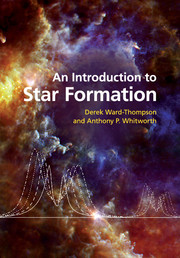Book contents
- Frontmatter
- Contents
- List of Illustrations
- Preface
- 1 Introduction
- 2 Probing star formation
- 3 The ISM – the beginnings of star formation
- 4 Molecular clouds – the sites of star formation
- 5 Fragmentation and collapse – the road to star formation
- 6 Young stars, protostars and accretion – building a typical star
- 7 The formation of high-mass stars, and their surroundings
- 8 By-products and consequences of star formation
- List of mathematical symbols
- List of figure credits
- Index
- References
2 - Probing star formation
Published online by Cambridge University Press: 05 June 2012
- Frontmatter
- Contents
- List of Illustrations
- Preface
- 1 Introduction
- 2 Probing star formation
- 3 The ISM – the beginnings of star formation
- 4 Molecular clouds – the sites of star formation
- 5 Fragmentation and collapse – the road to star formation
- 6 Young stars, protostars and accretion – building a typical star
- 7 The formation of high-mass stars, and their surroundings
- 8 By-products and consequences of star formation
- List of mathematical symbols
- List of figure credits
- Index
- References
Summary
Introduction
In the preceding chapter we discussed the main constituents of a galaxy. In this chapter we describe the ways in which we detect and measure those constituents. We also discuss the chief component that we have not yet mentioned – the radiation field.
We describe the various ways in which we learn about the Universe. We introduce fundamental concepts such as intensity, flux and opacity, and we show how these can be applied to both continuum radiation and spectral line radiation. These ideas are then used to illustrate how we can learn about the physical properties of the gas and dust in the interstellar medium.
Properties of photons
The majority of what we know about the Universe comes as a direct result of the electromagnetic (EM) radiation we receive from the Universe.
The other ways in which we learn about the Universe are space probes that travel to other bodies in the Solar System to discover the details of their composition, and from the meteors and meteorites that fall to Earth from time to time. Space probes can help us to learn about the formation of our own star, the Sun, and its planets, from which we may be able to extrapolate to the formation of other stars and their planets.
- Type
- Chapter
- Information
- An Introduction to Star Formation , pp. 21 - 38Publisher: Cambridge University PressPrint publication year: 2011



